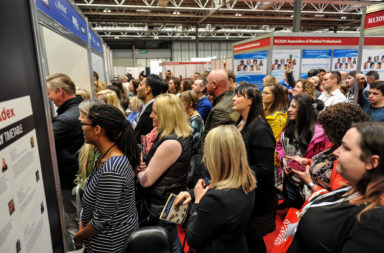This year marks 25 years since the first issue of Able Magazine rolled off the press. We’ve been looking back over that time at some of the more significant moments for disabled people.
By Tom Jamison
If we hadn’t invented Able Magazine in 1994, it’s almost certain that somebody else would’ve done so. The time was right for a publication that reflected the spirit of a (disabled) community that was beginning to agitate for fairness, respect and opportunity.
The social model of disability had been kicked around since the 1960s as a replacement to the ‘medical model’, arguing that while of course, physical, intellectual and sensory variations can cause impairments and/or limitations, that much of the time, it was the failure of Society, that actually causes disability.
The Disability Living Allowance and Disability Working Allowance were introduced in 1991 to help pay for the extra costs disabled people incur and other small but significant things were happening, such as The Spastics Society changing its name to Scope, pointing towards a new way of looking at disability. Nevertheless, as late as 1992 research indicated that there was still a long way to go, with 88% of polling stations found to be inaccessible, for example.
There was a need for a magazine to service the requirements of this burgeoning disabled community that wanted to understand their rights but was also looking for new experiences.
Since that point Able Magazine has been a leading contributor and analyst regarding ‘What disabled people can do, not what they can’t’. Here’s our brief digest of the last 25 years….
1995 – Civil rights
The Disability Discrimination Act 1995 (DDA) was introduced, placing a
duty on employers and service providers to make reasonable adjustments for disabled people to help them to overcome barriers they may face in gaining and remaining in employment and in accessing and using goods and services; very much in the spirit of the social model of disability.
The Act was updated in 2005 to promote the rights of disabled people ensuring that they weren’t subjected to discrimination because of their disability. In other words, they were people first and ‘disabled’, second. It was a landmark in gaining proper civil rights.
2000 – Enforcement
The Disability Rights Commission (DRC) was set up with a majority of disabled commissioners. The Commission had the right to investigate and enforce disability
2001 – Education
The Special Educational Needs and Disability Act 2001 established legal rights for disabled students in education by amending the DDA to include education. The Act ensures that disabled students are not discriminated against in education, training and any services provided for students, not only in schools but in further and higher colleges and universities as well.
2007 – Disability goes public, in Trafalgar Square
The fourth plinth in Trafalgar Square, London has been used to display a number of art installations but none quite as powerful as ‘Alison Lapper Pregnant’ by sculptor Marc Quinn, in 2007.
The story goes that Lapper had initially declined Quinn’s request because she wanted to make sure that she wasn’t depicted as a figure of pity. Quinn explained to her that throughout art, limbless statues such as Venus de Milo in The Louvre, were depictions of beauty and that he was aiming to create art depicting people born this way. When Quinn called Lapper a few months later, she informed him that she was now seven months pregnant. “That’s even better!” he replied.
2009 – United Nations Convention
It’s clear that the UK was already leading the way in what would later become known as “disability confidence”. The UN set out
2010 – United Nations Convention
It’s clear that the UK was already leading the way in what would later become known as “disability confidence”. The UN set out anti-discrimination legislation in 1995, with the UK ratifying the United Nations Convention on the Rights of Persons with Disabilities in 2009. Incredibly, there are still countries that haven’t managed to do so.
2012 – London hosts the Paralympic Games
The birthplace of the Paralympic movement had never before hosted a modern Paralympic Games. London was chosen as the host city in 2005 and very soon decided to produce the first legally combined ‘Olympic and Paralympic Games’ in 2012 which gave equal status to both.
London 2012 was a game-changer. Not only were the sporting events sold out – with an inspirational ParalympicsGB coming third overall on the medal table – but the whole country seemed to wake up to how incredible and inspirational parasport can be. Furthermore, it showed that the UK is capable of leading the way in provision for all of its citizens in accessible and universal design and architecture. The legacy of the Games is still being felt today.
2014 – Mental health
In recent years a new respect for mental health issues has emerged. In 2014 the then NHS England’s director for people with long term conditions, Dr Martin McShane, said: “We must end the stigma associated so often with mental health. We must raise awareness of the importance of mental health care and recognise the inadequacies of how we have regarded mental health in the past. This means raising awareness within the NHS itself. And we must create parity for mental health care in reality – rather than just issuing rhetoric and paying lip service to it.”
2016 – Disability Confident
Official government guidance and resources about employing disabled people were launched under the banner, Disability Confident. In 2016 it was updated and officially replaced the Two Ticks Scheme with 5,000 organisations signing up in the year to 2017.
As the 2017 General Election approached, the Green Party and Labour party both produced specific disability manifestos. The Green Party document was launched by their candidate in Putney, Ben Fletcher, who is deafblind. He managed to reduce Conservative, Justine Greening’s majority from 10,000 down to just 1,500.
2017 – Back to basics
Even though great strides had been made, incredibly, some very basic provisions for disabled people have only been introduced recently. For instance, it was only in 2017 that the British Medical Association’s annual meeting unanimously passed a motion calling for wheelchair users to have “timely access to chairs suitable for their individual conditions”. Dame Tanni Grey-Thompson said, “If a child doesn’t have the right chair it means they cannot go to school, it means children are harder to handle for parents, it means potentially more respite care.”
2018 – Be the Difference
In July 2018 Able Magazine launched its employment initiative, ‘Be the Difference’, with the specific aim of helping more disabled people find employment. The aim is to match employers with vacancies and disabled people through the initiative and is an attempt to make a real change, working towards closing the employment gap that exists between able-bodied and disabled people.
www.ablemagazine.co.uk/bethedifference
btd@primasmedia.co.uk
2019 – What’s next?
Back in
More importantly though, is that there is the social and political will to find further applications to enable disabled people to play a full part in Society, with more inclusion and less segregation. Whatever happens, Able Magazine will be there to tell you all about it.



